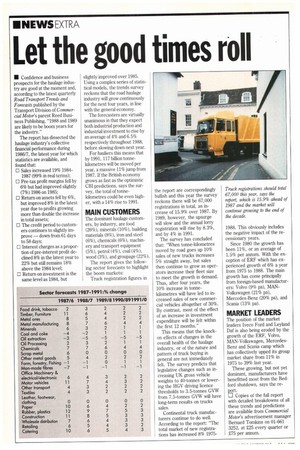Let the good times roll
Page 12

If you've noticed an error in this article please click here to report it so we can fix it.
• Confidence and business prospects for the haulage industry are good at the moment and, according to the latest quarterly Road Transport Trends and Forecasts published by the Transport Division of Commercial Motor's parent Reed Business Publishing, "1988 and 1989 are likely to be boom years for the industry."
The report has dissected the haulage industry's collective financial performance during 1986/7, the latest year for which statistics are available, and found that: o Sales increased 19% 19841987 (99% in real terms); El Pre-tax profit margins fell by 6% but had improved slightly (7%) 1986 on 1985; El Return on assets fell by 6%, but improved 8% in the latest year due to profits growing more than double the increase in total assets; The credit period to customers continues to slightly improve — down from 61 days to 58 days; O Interest charges as a proportion of pre-interest profit declined 8% in the latest year to 22% but still remains 18% above the 1984 level; D Return on investment is the same level as 1984, but slightly improved over 1985. Using a complex series of statistical models, the trends survey reckons that the road haulage industry will grow continuously for the next four years, in line with the general economy.
The forecasters are virtually unanimous in that they expect both industrial production and industrial investment to rise by an average of 4% and 6. 5% respectively throughout 1988, before slowing down next year.
For hauliers this means that by 1991, 117 billion tonnekilometres will be moved per year, a massive 11% jump from 1987. If the British economy grows as fast as the optimistic CI31 predictions, says the survey, the total of tonnekilometres could be even higher, with a 14% rise to 1991.
MAIN CUSTOMERS
The dominant haulage customers, by industry, are food (26%), minerals (10%), building materials (8%), iron and steel (6%), chemicals (6%), machinery and transport equipment (5%), petrol (4%), coal (4%), wood (3%), and groupage (22%).
The report gives the following sector forecasts to highlight the boom markets: Truck registration figures in the report are correspondingly bullish and this year the survey reckons there will be 67,000 registrations in total, an increase of 15.9% over 1987. By 1989, however, the upsurge will slow and the annual lorry registration will rise by 8.3%, and by 4% in 1991.
The survey has concluded that: "When tonne-kilometres moved by road goes up 10% sales of new trucks increases 5% straight away, but sales then continue to grow as operators increase their fleet size to meet the growth in demand. Thus, after four years, the 10% increase in tonnekilometres will have led to increased sales of new commercial vehicles altogether of 30%. By contrast, most of the effect of an increase in investment expenditure will be felt within the first 12 months."
This means that the knockon effects of changes in the overall health of the haulage industry, or of the nature and pattern of truck buying in general are not immediately felt. The survey predicts that legislative changes such as increasing UK gross vehicle weights to 40-tonnes or lowering the HGV driving licence thresholds to 3.5-tonnes GVW from 7.5-tonnes GVW will have long-term results on trucks sales.
Continental truck manufacturers continue to do well. According to the report: "The total market of new registrations has increased 8% 1975 Truck registrations should total 67,000 this year, says the report, which is 15.9% ahead of 1987 and the market will continue growing to the end of the decade.
1988. This obviously includes the negative impact of the recessionary years.
Since 1980 the growth has been 11%, Or an average of 1.5% per annum. With the exception of ERF which has experienced growth of 6% a year from 1975 to 1988. The main growth has come principally from foreign-based manufacturers: Volvo (9% pa), MANVolkswagen (21% pa), Mercedes-Benz (20% pa), and Scalia (13% pa).
MARKET LEADERS
The position of the market leaders Nem Ford and Leyland Daf is also being eroded by the growth of the ERF, Volvo, MAN-Volkswagen, MercedesBenz and Scania camp which has collectively upped its group market share from 11% in 1975 to 39% last year.
These growing, but not yet dominant, manufacturers have benefitted most from the Bedford shutdown, says the re Copies of the full report with detailed breakdowns of all these trends and predictions are available from Commercial Motor's advertisement manager Bernard Tomkins on 01-661 3252, at 225 every quarter or 275 per annum.
































































































